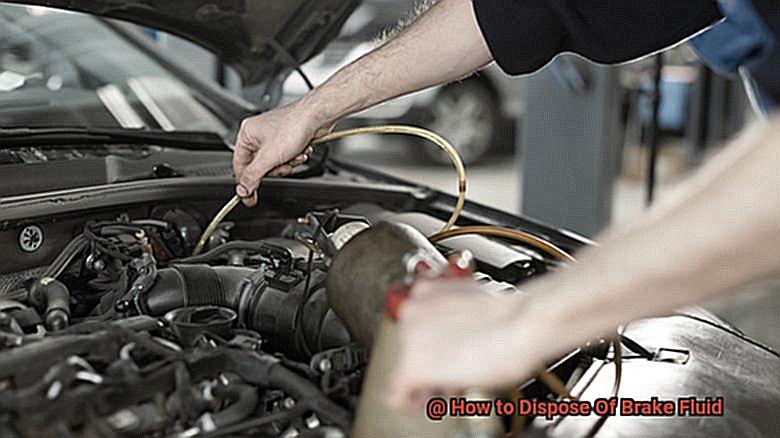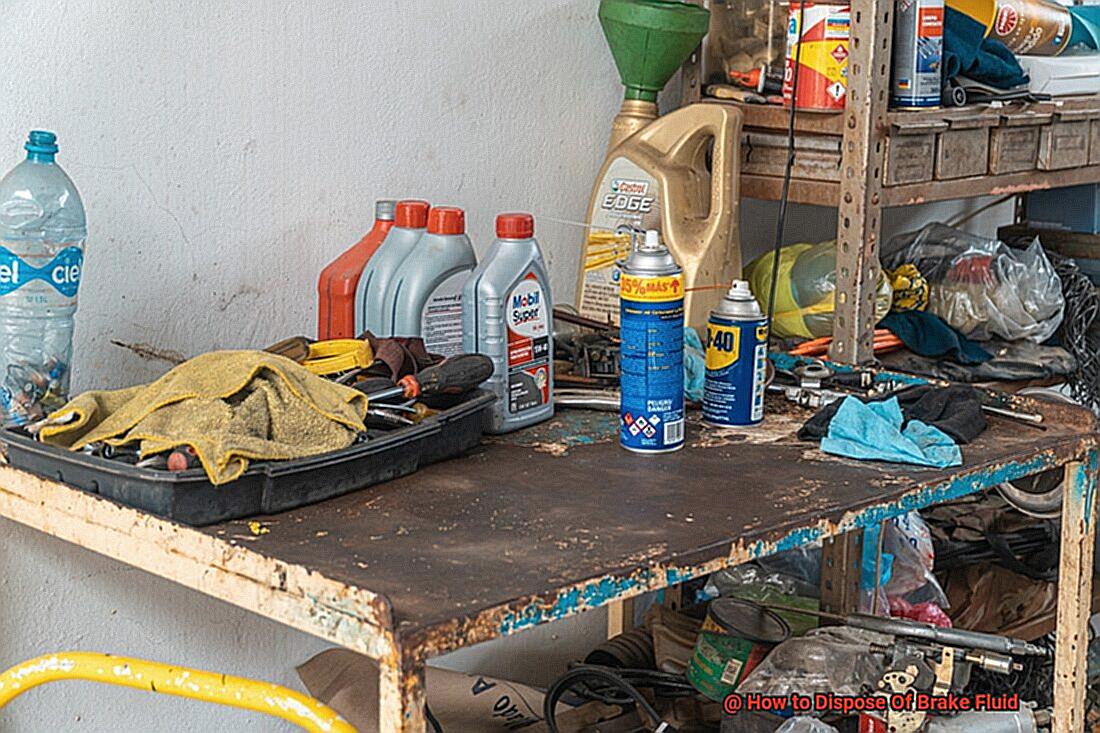Do you know how to dispose of brake fluid? It’s essential to do it properly. Disposal that’s not up to standard can cause serious environmental damage—and even criminal consequences.
In this blog post, we’ll look at why it’s so important to get rid of brake fluid the right way. We’ll also provide tips on how to do it safely and responsibly.
So, if you want to make sure you’re doing your part for the planet, read on.
The Dangers of Improper Disposal of Brake Fluid
Contents
- 1 The Dangers of Improper Disposal of Brake Fluid
- 2 Is it OK to Dispose of Brake Fluid by Throwing it Away?
- 3 How to Dispose Of Brake Fluid Safely
- 3.1 Take it to a Recycling Center or Hazardous Waste Facility
- 3.2 Use an Absorbent Material
- 3.3 Wear Protective Clothing and Gloves
- 3.4 Check with your local government for rules and regulations.
- 3.5 Label Containers and Store In A Secure Location
- 3.6 Proper Storage of Brake Fluids
- 3.7 Different Types of Brake Fluids
- 3.8 Avoiding Contamination
- 3.9 Safety Precautions
- 3.10 Disposal Guidelines
- 4 Mistakes to Avoid When Disposing of Brake Fluid
- 5 Alternatives for Reusing or Recycling Used Brake Fluid
- 6 What to Do if You Spill Brake Fluid on the Ground
- 7 Conclusion
Brake fluid is a vital component of your vehicle’s braking system, but if it is not treated and disposed of properly, it can become a serious hazard. Improper disposal of brake fluid can lead to contamination of local water supplies, soil, and air. This pathogen is toxic to humans, animals, and plants alike.
It’s essential to be aware of the laws in your area when disposing of brake fluid. Never pour it down a sink or toilet, or throw it into storm drains or on the ground. The best way to get rid of brake fluid is to take it to a hazardous waste facility or have it collected by an approved waste management company.
We all have a responsibility to protect our environment from potential harm caused by auto repair materials like brake fluid.

Taking the extra steps necessary to properly dispose of brake fluid will go a long way towards ensuring that our environment remains safe and healthy for future generations.
Is it OK to Dispose of Brake Fluid by Throwing it Away?
When it comes to brake fluid, throwing it away is never an option. This hazardous material contains polyglycol ethers, which are toxic to the environment and can be damaging to plants and animals if not disposed of properly.
Additionally, brake fluid has the potential to cause staining on concrete and other surfaces if spilled or leaked. So, when it comes time to dispose of your brake fluid, make sure you do it correctly.
How to Dispose Of Brake Fluid Safely
Disposing of brake fluid safely is essential for protecting the environment and avoiding any potential health risks. This guide will provide you with the information you need to ensure that your brake fluid is disposed of in a responsible manner.
Take it to a Recycling Center or Hazardous Waste Facility
The best way to dispose of brake fluid is to take it to a local recycling center or hazardous waste facility. This ensures that the brake fluid is disposed of in an environmentally friendly manner and prevents any potential contamination of water sources.
Use an Absorbent Material
If you are unable to take the brake fluid to a recycling center or hazardous waste facility, you can also use an absorbent material such as kitty litter or sawdust in a container with a lid and let it sit for several days before disposing of it. This will help prevent leaks from contaminating water sources and minimize water contamination.
Wear Protective Clothing and Gloves
Always wear protective gloves and clothing when handling brake fluid, and make sure that any spills are cleaned up immediately. This will help you avoid any potential health issues related to exposure to brake fluid.
Check with your local government for rules and regulations.
Be sure to check with your local government for any regulations or restrictions on how to dispose of brake fluid, as they can vary from state to state or country to country.
Label Containers and Store In A Secure Location
Be sure to label all containers of brake fluid clearly and store them in a secure location until they can be disposed of properly. This will help ensure that the containers are not lost or misplaced and that they can be identified when they are scheduled for disposal at a later date.
Tips for Proper Storage of Brake Fluid Before Disposal
Proper Storage of Brake Fluids
For a safe and enjoyable driving experience, it is essential to maintain your brakes in top condition. This means paying attention to the proper storage of brake fluids, as this will ensure that they are in optimal condition for use.
When storing brake fluid, make sure it is kept in a cool, dry, and dark place away from any heat sources or direct sunlight.
Additionally, keep the container tightly sealed to avoid contamination and check the expiration date of the fluid before using it.
It’s also important to keep the container away from any flammable materials or combustible liquids, as they can react with the brake fluid and create a fire hazard.
Different Types of Brake Fluids
There are many different brands of brake fluid on the market today, each with its own unique characteristics and specifications. Before buying or using any form of brake fluid, be sure to read the label on the container carefully, as mixing several types of brake fluid can lead to poor performance and damage your brakes.
Additionally, store each type separately so as to avoid contamination or degradation over time.
Avoiding Contamination
When storing brake fluid, it is essential to ensure that it does not come into contact with any dirt or rubble, which may lead to poor performance or even failure if left unchecked. To prevent contamination during transit, make sure you move brake fluid from one location to another by using clean containers only.
Safety Precautions
When handling or storing brake fluids, safety measures must be taken, such as wearing protective gloves and eyewear; keeping the container away from children and pets, and being up-to-date on local laws regarding disposal of used fluids in order to properly dispose of them without putting yourself at risk for legal consequences.
Disposal Guidelines
After you have finished using old brake fluids, it is important to dispose of them safely according to local laws and guidelines developed by your municipality or state government, usually by taking them to a licensed hazardous waste facility where they can be discharged without causing harm or damage to the environment around them.
Additionally, follow all safety regulations when transporting used fluids so that you do not put yourself at risk for accidents while doing so.
Mistakes to Avoid When Disposing of Brake Fluid
Disposing of brake fluid can be tricky, but it’s essential to do it correctly in order to protect yourself and the environment. Here are some of the most important mistakes to avoid when disposing of brake fluid:
First and foremost, never pour brake fluid down or into a body of water. Doing so can have disastrous consequences for the climate, as well as for humans and animals.
Second, don’t discard brake fluid in the trash without proper containment. Make sure you place it in a sealed container first to prevent any leakage or contamination.
Third, never let brake fluid come into contact with skin, eyes, or clothing. If you do get any on you, make sure to wash it off with soap and water immediately.
Fourth: Don’t mix different types of brake fluid together. Different brands of brake fluid have different characteristics, and mixing them together can cause serious damage to your brakes.
Finally, make sure to use the correct type of brake fluid for your vehicle and dispose of it properly when it is no longer needed.
Alternatives for Reusing or Recycling Used Brake Fluid
There are plenty of alternatives for reusing or recycling it!
For starters, you can take it to a recycling center. The oil will be separated from the water and then processed into a usable product. This is an excellent way to conserve resources and reduce waste.
You can also repurpose the brake oil. If it’s still in good condition and not contaminated, it can be reused after being filtered and tested for quality assurance. This is especially helpful if you’re servicing or repairing your vehicle, as it can save you money while helping you do your part for the environment.
What to Do if You Spill Brake Fluid on the Ground
If you spill brake fluid on the ground, it is essential to take immediate action. Follow these five steps to clean up the leak and protect your environment.
Absorb the Spill
The first step is to quickly absorb as much of the brake fluid as possible with a cloth or paper towel. Once you’ve done this, dispose of it in a sealed container.
Clean Hard Surfaces
If the spill is on a hard surface, such as concrete, use a detergent solution to clean the area. Make sure to rinse off any remaining soap with clean water afterwards.
Remove Contaminated Soil
If the leak is in the soil, you will need to dig up the contaminated soil and replace it with fresh soil from another location. The contaminated soil should be disposed of properly according to local regulations.
Avoid Using Water
Do not attempt to wash away brake fluid spills with water, as this could contaminate groundwater sources or create hazardous runoff that can harm local ecosystems.
Contact Waste Management Authority
Contact your local waste management authority for information about proper disposal methods for any remaining brake fluid or cleaning materials used in the cleanup process.
Conclusion
Vehicle care is essential to keeping your car in top condition, and brake fluid is a key element of that. But it’s also a hazardous substance that must be handled with caution and disposed of correctly.
By following the guidelines outlined here, you can ensure that your brake fluid will be disposed of safely, without risk to our planet or those around us.
Doing it right is vital for protecting our climate and preserving future generations’ wellbeing.





